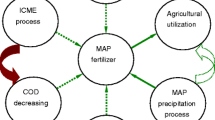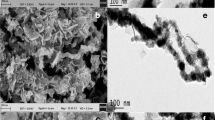Abstract
The wastewater containing phosphorus (P) and copper (Cu) is produced in large quantities during manufacturing processes such as electroless plating of Cu. The focus of this work is to develop a green and cost-efficient process for the co-removal of P and Cu from wastewater. An iron-enhanced dolomite process was employed to treat the phosphate (PO4–P) and copper contaminated water. The results showed that the co-removal of PO4–P and Cu was feasible by adjusting parameters as reagent dosage, molar ratio, stirring time, and pH. Under the conditions of Ca/Fe molar ratio of 4:1, Fe/(P+Cu) molar ratio of 1:1, initial pH of 5.6~10.0, and stirring for 30 min, the removal rates of PO4–P and Cu exceeded 99%. The mechanism research showed that the Fe ions was critical to the removal of PO4–P, which mainly removed by forming insoluble amorphous precipitate. The raw CaMg(CO3)2 is susceptible to corrosion by Cu ions and resulting in the production of flaky particles, which have two-dimensional nanostructured. The two-dimensional nanostructured is conducive to increase the contact area of particles with ions in solution, improving the chemical reactivity and adsorption. The Cu ions are likely to be removed in the form of posnjakite. The process has the advantages of being green and cost-efficient, and has a good practical application prospect for the PO4–P and Cu removal.










Similar content being viewed by others
Data Availability
The data that support the findings of this study are available from the corresponding author upon reasonable request.
References
Abdul Khalil, H. P. S., Chong, E. W. N., Owolabi, F. A. T., Asniza, M., Tye, Y. Y., Tajarudin, H. A., Paridah, M. T., & Rizal, S. (2018). Microbial-induced CaMg(CO3)2 filled seaweed-based film for green plasticulture application. Journal of Cleaner Production, 199, 150–163.
Awual, M. R. (2019). Efficient phosphate removal from water for controlling eutrophication using novel composite adsorbent. Journal of Cleaner Production, 228, 1311–1319.
Badsha, M. A. H., & Lo, I. M. C. (2020). An innovative pH-independent magnetically separable hydrogel for the removal of Cu(II) and Ni(II) ions from electroplating wastewater. Journal of Hazardous Materials, 381, 121000.
Chen, D., Zhang, C., Rong, H., Zhao, M., & Gou, S. (2020). Treatment of electroplating wastewater using the freezing method. Separation and Purification Technology, 234, 116043.
Clark, T., Stephenson, T., & Pearce, A. (1997). Phosphorus removal by chemical precipitation in a biological aerated filter. Water Research, 31(10), 2557–2563.
Fu, F. L., & Wang, Q. (2011). Removal of heavy metal ions from wastewaters: A review. Journal of Environmental Management, 92(3), 407–418.
Guo, Z., Li, J., Guo, Z., Guo, Q., & Zhu, B. (2017). Phosphorus removal from aqueous solution in parent and aluminum-modified eggshells: Thermodynamics and kinetics, adsorption mechanism, and diffusion process. Environmental Science and Pollution Research International, 24(16), 14525–14536.
Lan, S., Ju, F., & Wu, X. (2012). Treatment of wastewater containing EDTA-Cu(II) using the combined process of interior microelectrolysis and Fenton oxidation–coagulation. Separation and Purification Technology, 89, 117–124.
Lei, Y., Narsing, S., Saakes, M., van der Weijden, R. D., & Buisman, C. J. N. (2019). Calcium carbonate packed electrochemical precipitation column: New concept of phosphate removal and recovery. Environmental Science & Technology, 53(18), 10774–10780.
Li, X., Zhang, Q., & Yang, B. (2020). Co-precipitation with CaMg(CO3)2 to remove heavy metals and significantly reduce the moisture content of filter residue. Chemosphere, 239, 124660.
Liang, S., Zheng, W., Zhu, L., Duan, W., Wei, C., & Feng, C. (2019). One-step treatment of phosphite-laden wastewater: A single electrochemical reactor integrating superoxide radical-induced oxidation and electrocoagulation. Environmental Science & Technology, 53(9), 5328–5336.
Liu, Y., Shi, H., Li, W., Hou, Y., & He, M. (2011). Inhibition of chemical dose in biological phosphorus and nitrogen removal in simultaneous chemical precipitation for phosphorus removal. Bioresource Technology, 102(5), 4008–4012.
Morse, G. K., Brett, S. W., Guy, J. A., & Lester, J. N. (1998). Review: Phosphorus removal and recovery technologies. Science of The Total Environment, 212(1), 69–81.
Qi, Y., Thapa, K. B., & Hoadley, A. F. A. (2011). Application of filtration aids for improving sludge dewatering properties – A review. Chemical Engineering Journal, 171(2), 373–384.
Ramasahayam, S. K., Guzman, L., Gunawan, G., & Viswanathan, T. (2014). A comprehensive review of phosphorus removal technologies and processes. Journal of Macromolecular Science A, 51(6), 538–545.
Ramasamy, V., Anand, P., & Suresh, G. (2018). Synthesis and characterization of polymer-mediated CaMg(CO3)2 nanoparticles using limestone: A novel approach. Advanced Powder Technology, 29(3), 818–834.
Wang, H., Dong, W., Li, T., & Liu, T. (2015). A modified BAF system configuring synergistic denitrification and chemical phosphorus precipitation: Examination on pollutants removal and clogging development. Bioresource Technology, 189, 44–52.
Zhang, J., Bligh, M. W., Liang, P., Waite, T. D., & Huang, X. (2018). Phosphorus removal by in situ generated Fe(II): Efficacy, kinetics and mechanism. Water Resources., 136, 120–130.
Zhang, T., Zhao, Y., Kang, S., Li, Y., & Zhang, Q. (2019). Formation of active Fe(OH)3 in situ for enhancing arsenic removal from water by the oxidation of Fe(II) in air with the presence of CaMg(CO3)2. Journal Cleaner Production, 227, 1–9.
Zhou, K., Wu, B., Su, L., Gao, X., Chai, X., & Dai, X. (2017). Development of nano-CaO2-coated clinoptilolite for enhanced phosphorus adsorption and simultaneous removal of COD and nitrogen from sewage. Chemical Engineering Journal, 328, 35–43.
Author information
Authors and Affiliations
Corresponding author
Ethics declarations
Conflict of Interest
The authors declare that no competing interests.
Additional information
Publisher's Note
Springer Nature remains neutral with regard to jurisdictional claims in published maps and institutional affiliations.
Rights and permissions
Springer Nature or its licensor (e.g. a society or other partner) holds exclusive rights to this article under a publishing agreement with the author(s) or other rightsholder(s); author self-archiving of the accepted manuscript version of this article is solely governed by the terms of such publishing agreement and applicable law.
About this article
Cite this article
Guan, H. Efficient Simultaneous Removal of Phosphorus and Copper from Wastewater by an Iron-Enhanced Dolomite Process. Water Air Soil Pollut 234, 776 (2023). https://doi.org/10.1007/s11270-023-06805-8
Received:
Accepted:
Published:
DOI: https://doi.org/10.1007/s11270-023-06805-8




